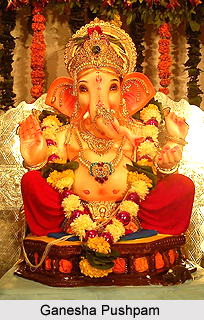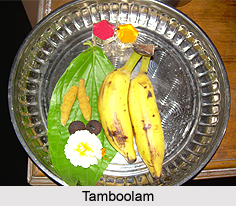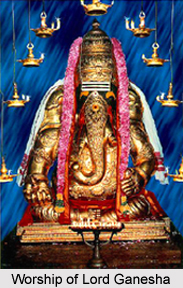 Shodashopachara refers to the sixteen types of rituals that are followed during the worship of Lord Ganesha. These sixteen steps are Aavahanam, Aasanaam, Paadyam, Arghyaam, Aachamaneeyam, Snaanaam, Vastram, Yagyopaveetam, Gandham. Aksataam. Pushpam, Dhoopam, Deepam, Naivedyam, Tamboolam and Dakshanaam. The legend of Lord Ganesha and Tulsi mentions that Tulsi (Holy Basil) leaves are used for Ganesha worship only during Ganesh Chaturthi. The rituals of worship start with the performance of Pranprathishta by the priest. This ritual is believed to invoke life into the idol of Lord Ganesha. Then the image is smeared with Red Sandalwood paste or Rakta Chandana. After this process is completed, the elephant-headed deity is worshipped by performing the Shodashopachara rituals. These are mentioned as follows-
Shodashopachara refers to the sixteen types of rituals that are followed during the worship of Lord Ganesha. These sixteen steps are Aavahanam, Aasanaam, Paadyam, Arghyaam, Aachamaneeyam, Snaanaam, Vastram, Yagyopaveetam, Gandham. Aksataam. Pushpam, Dhoopam, Deepam, Naivedyam, Tamboolam and Dakshanaam. The legend of Lord Ganesha and Tulsi mentions that Tulsi (Holy Basil) leaves are used for Ganesha worship only during Ganesh Chaturthi. The rituals of worship start with the performance of Pranprathishta by the priest. This ritual is believed to invoke life into the idol of Lord Ganesha. Then the image is smeared with Red Sandalwood paste or Rakta Chandana. After this process is completed, the elephant-headed deity is worshipped by performing the Shodashopachara rituals. These are mentioned as follows-
Aavahanam
Aavahanam means invocation of the Lord. Ganesha is requested to arrive and participate in the religious ceremony
Aasanaam
In this step, comfortable and suitable seating arrangements are prepared for the deity.
Paadyam
The third ritual is the Paadyam. The feet of the Ganesha idol is washed with aromatic water containing with rose petals. Then the feet of the Lord is wiped with towels. Particular foot service is also offered to Ganesha.
Arghyaam
 In the fourth step for worshipping Ganesha, Arghyaam is performed. Scented and cool water is prepared specially and served to Lord Ganesha to quench the thirst of the deity.
In the fourth step for worshipping Ganesha, Arghyaam is performed. Scented and cool water is prepared specially and served to Lord Ganesha to quench the thirst of the deity.
Aachamaneeyam
Aachamaneeyam refers to the ritual of sipping the sanctified water. The holy water is sipped from the palm by the priest for internal purification. It is done before beginning the worship. The devotees participating the worship or puja also perform Aachamaneeyam.
Snanaam
In this step the Lord is offered a ritualistic bath. The Ganesha idol is bathed with purified water that has been blessed with mantras which invokes all the holy Indian rivers namely Ganga (Ganges), Narmada, Yamuna, Kaveri, Saraswati and others. Sugar, Honey, Ghee, Yoghurt (Curd) and Milk are mixed with the sanctified water. This mixture is called Panchaamrita. The water of Ganga River is considered as a form or swaroop of Goddess Ganga. Hence water of the holy river is believed to be as pure as the goddess. The waters of other sacred rivers, like Tapi and Yamuna are also considered pure.
Vastram
Vastram is the offering of clothes made to the Lord. Ganesha is adorned with soft, brightly-colored silk garments. The dress includes Anga Vastra and a Dhoti.
Yajnopavitam (Yagyopaveetam)
In the eighth step in the worship of Lord Ganesha, the sacred thread is offered to the deity. The Sacred Thread, known as Janoi, is placed across the shoulder of the image of Ganesha.
Gandham
Gandham refers to offering of fragrance. Attar or perfume is smeared all over the idol. Chandan or Sandalwood paste is also anointed over the Lord.
Aksataam
Aksataam refers to the offering of grains in Ganesha worship.
Pushpam
Pushpam is the eleventh step in adoration of the deity. Several types of flowers (Pushpa) and flower garlands with pleasant scent are offered to Ganesha. Red Hibiscus flower and twenty one Durva grass (Bermuda grass) are generally used in the rituals.
 Dhoopam
Dhoopam
This step refers to the lighting of fragrant incense sticks. It is believed that the incense sticks purifies the atmosphere.
Deepam
In this step, Deepas and Diyas (lamps with ghee immersed wicks) are lighted in the Lord`s worship.
Naivedyam
Naivedyam is the offering of various types of specially prepared foods, seasonal fruits and sweets. Modaka (sweet balls) and Laddoos are always offered in Ganesha worship.
Tamboolam
Tamboolam or Thambulam is the offering of betel leaf (Paan) and betel nuts to Lord Ganesha. It is prepared by rolling a betel leaf which contains betel nuts and fresh mints. Then it is immersed in rose water and garnished with dry strands of coconut.
Dakshanaam
In the final step of Ganesha worship, the priest is presented with a coin. It is considered as a payment for performing the ceremony. Dakshanaam is primarily a show of gratitude to the priest.
Apart from these, some other steps are followed in worship of Ganesha. Neerajanam is a ritual where an Aarti is performed in adoration of the Lord. Then the worshipper offers Namaskaram where he bows to the deity in reverence. Another ritualistic step in Ganesha worship is Pradakshina. Here the devotee circumambulates the idol of the Lord. Mantra Pushpa is also believed to be a step where the worshipper recites different mantras of Lord Ganesha.
During the performance of Shodashopachara or the sixteen rituals for Ganesha Worship, four kinds of urns or vases are required. These are listed below-
* Vase for washing the feet of the idol with sacred fragrant water, lotus flower and Durva grass (Paadyam).
* Vase for offering blessed water to the Lord to quench His thirst (Arghyaam) and also for presenting flowers, Kusa grass, Durva grass, rice, curd, betel nut, seasamum and vermilion.
* Vase for sipping sanctified water mixed with cloves, nutmeg, astanga etc.
* Vase for bathing and cleaning the idol with sacred water, flowers, perfume and rice (Snanaam).




















